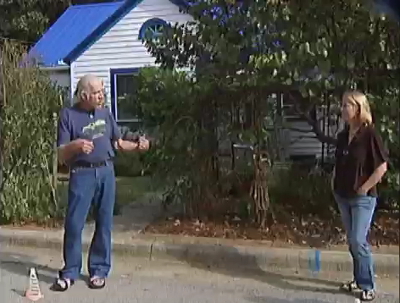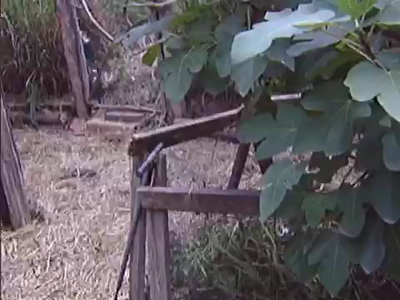
Tour of Will Hooker's home, part 2
 As I delved into the next
round of permaculture
lectures, it
became clear that the professor had included some topics out of
order to fit his field-trip schedule. Since we don't have
that restriction, I recommend you skip around with me and watch
lectures 5, 11, and 12 as a set before moving on to lecture 6.
As I delved into the next
round of permaculture
lectures, it
became clear that the professor had included some topics out of
order to fit his field-trip schedule. Since we don't have
that restriction, I recommend you skip around with me and watch
lectures 5, 11, and 12 as a set before moving on to lecture 6.
Lecture 11 should
really have gone along with the slideshow
tour of the professor's urban homestead since this later
"lecture" is a field trip to the professor's house. You'll
end up seeing some of the same information over again, but lecture
11 adds in Hooker's wife's perspective, and you also learn more
specifics about variety selection (Black Mission is his favorite
fig) and design. (Keep in mind that varieties that work well
for him are more likely to suit your homestead if you live in an
urban environment near Raleigh, North Carolina, which is in zone
7b. Some of his favorites have failed miserably for us here
in rural zone 6.)
My favorite part of
the tour was the twenty minutes Hooker spent in the chicken run
(starting around an hour and four minutes into the video).
I'm still working on the best way to match chickens up with
compost, and I liked his method of keeping an open-topped compost
bin in the chicken run and just letting the chickens hop in and
eat what they want. Although pastures provide more food if
you have the space, Hooker's mulched yard also  looked very effective for
the urban environment. He provides about 10 square feet per
bird, keeps the whole area mulched with straw, then rakes out the
mulch every two to four weeks to use on the garden. Finally,
he has planted peaches, figs, and kiwis in the run, protecting the
last with 3-foot lengths of black PVC pipe, which keeps chickens
from eating the tender vines and also protects their bases from
late freezes.
looked very effective for
the urban environment. He provides about 10 square feet per
bird, keeps the whole area mulched with straw, then rakes out the
mulch every two to four weeks to use on the garden. Finally,
he has planted peaches, figs, and kiwis in the run, protecting the
last with 3-foot lengths of black PVC pipe, which keeps chickens
from eating the tender vines and also protects their bases from
late freezes.
Stay tuned for my
next post, which will cover lectures 5 and 12, and also the
reading for this section of the course:
Want more in-depth information? Browse through our books.
Or explore more posts by date or by subject.
About us: Anna Hess and Mark Hamilton spent over a decade living self-sufficiently in the mountains of Virginia before moving north to start over from scratch in the foothills of Ohio. They've experimented with permaculture, no-till gardening, trailersteading, home-based microbusinesses and much more, writing about their adventures in both blogs and books.
Want to be notified when new comments are posted on this page? Click on the RSS button after you add a comment to subscribe to the comment feed, or simply check the box beside "email replies to me" while writing your comment.
